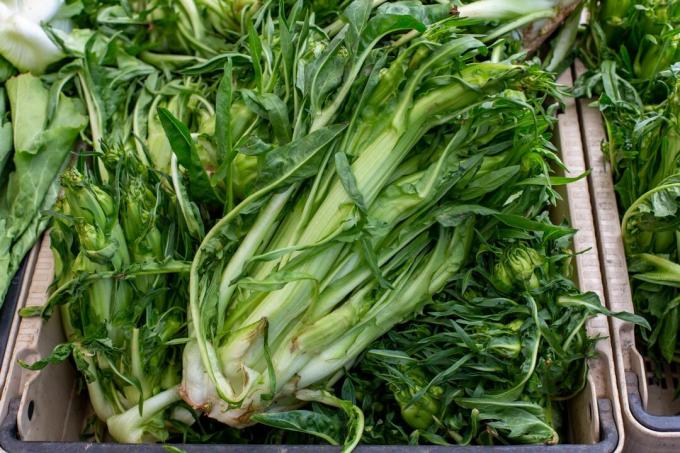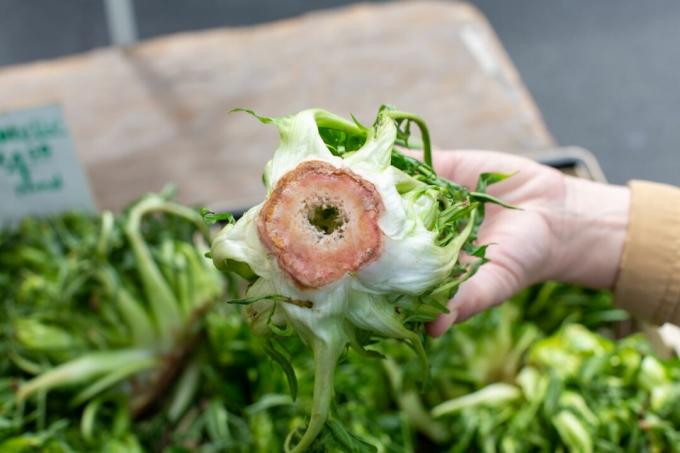Grow puntarelle in your own garden: We present suitable varieties and give tips and tricks on everything from sowing to care and fertilization to harvesting.

The winter vegetable with dozens of names is closely related to the well-known chicory. The names go from Puntarelle (Cichorium intybus) via Cimata, asparagus chicory or volcanic asparagus and in Italian the popular vegetable is also known as Catalogna Soigata, Cicoria asparago, Cicoria di Catalogna or Cataluna. In almost every Italian region, vegetables have a different name and are regularly served. In Germany, the puntarelle is only known to gourmets, but it is highly valued as a special kind of chicory. Probably the biggest difference to chicory is the shorter stems. These in turn are well protected inside by the bracts. The plump, hollow shoots are particularly popular with gourmets. For harvest, the not yet fully ripe inflorescences are broken out and prepared in a wide variety of ways. The Cimata thrives splendidly in German gardens, and cultivation is also worthwhile for beginners.

Cultivating Puntarelle, Cimata - this is how it works step by step
We will take you through the gardening year with brief instructions - from the seeds to the delicious puntarelle from your garden.
- Cimata seeds can usually only be obtained from specialized dealers. With a little luck, your gardener around the corner can also order seeds for you on request.
- Before you start sowing, you need to decide whether you want to grow outdoors or on the balcony, patio or in the greenhouse.
- You can sow the seeds from mid-April. These should be pressed about 1 cm deep into the earth. The distance between the individual Cimata plants should be around 50 to 60cm. If you prick out after a few weeks, you can of course sow more densely. For the supply of fresh vegetables from your own garden in winter time should be sawed at the beginning of August.
- The choice of the location should be carefully considered. This should be very sunny and at the same time offer sufficient protection to protect the plant from too low temperatures during the cold season. For the winter period, the plant is recommended to grow on the terrace or on a protected house wall. It is best to harvest the Puntarella before the first heavy frosts (> -5 ° C).
- The volcanic asparagus has high demands on the soil conditions. If the soil in your garden is not rich in humus and nutrients, you have to fill the planting trough with compost, horse manure and, if necessary, Mend horn shavings. Also a pre-fertilized organic soil like our Plantura Organic tomato & vegetable soil works well. Please note that an insufficient supply of nutrients allows the puntarelle to grow, but then its bitter substances appear more, which can lead to an almost inedible result.
- The distance between the puntarelle plants should be at least half a meter.
- You can provide additional nutrients once a month with a complete fertilizer. Also a mainly organic long-term fertilizer like our Plantura Organic tomato fertilizer you can use. However, you should definitely stop at least six weeks before the first harvest, otherwise the taste will be negatively affected.
- The Cimata also needs a good supply of moisture, but this is only necessary in the first few weeks after sowing. Because in our latitudes, increased precipitation is to be expected from September. Weeds should be regularly removed from the soil around the plant and loosened up a little.
- You can harvest from the beginning of August until winter. As soon as the cold time approaches, you should keep an eye on the precious vegetables and check them regularly. If it gets too cold, the harvest can be quickly gone. Depending on the time of sowing, the tasty winter vegetables can also be harvested gradually over the winter. Here you can protect the heads of lettuce on the Cimata from sub-zero temperatures with a fleece cover.

Many thanks to the two photographers: SingerFood and studiodobs © photography
